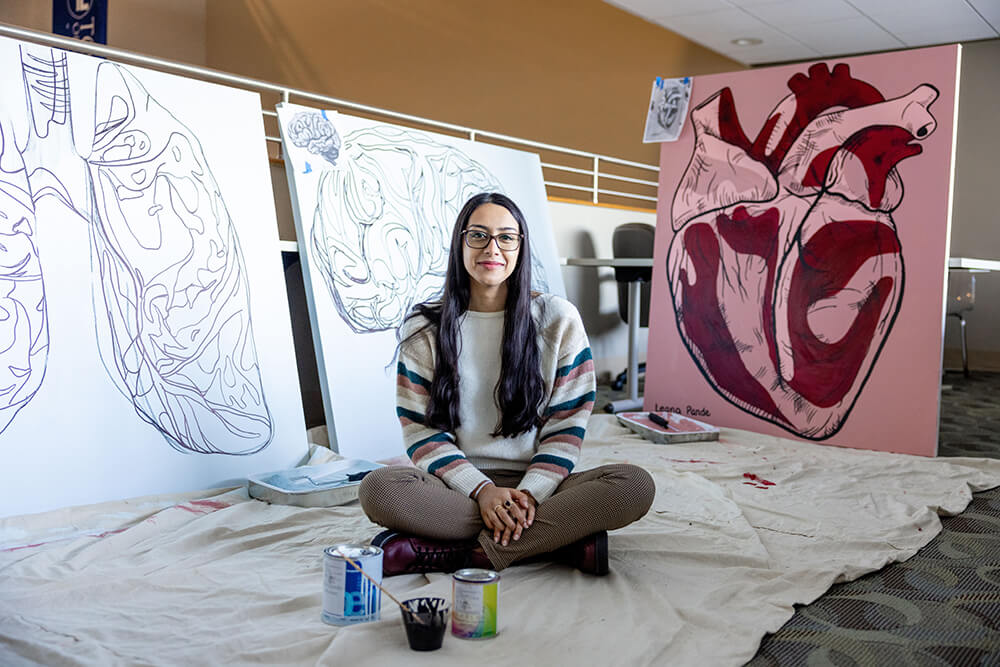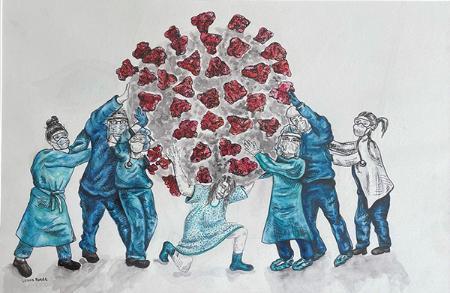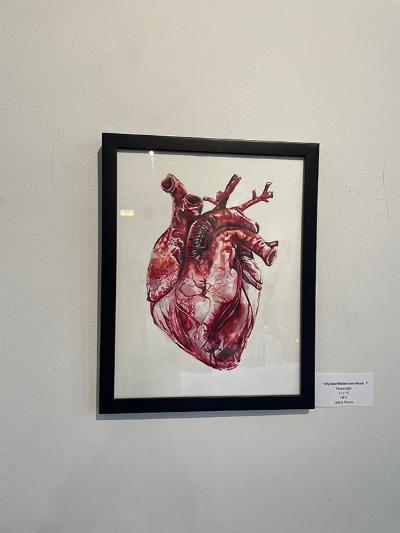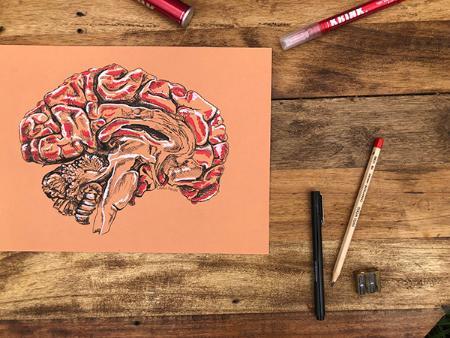Blending Art and Medicine at Touro College of Osteopathic Medicine Middletown
Leana Pande, OMS-I, Translates a Vision of Beauty in Human Organs with Accuracy

The world is full of talented artists and accomplished physicians – but how many successfully combine the two, excelling at both?
Leana Pande, OMS-I at Touro College of Medicine in Middletown is one, who is choosing medicine over art as her career. But along the way she is painting and drawing whenever and wherever she gets the chance and receiving kudos for creating accurate depictions of human anatomy.
“I don’t know why I paint,” says Pande. “People always ask me about some sort of motivation. I just see something and take a million pictures and paint it later. I have a list of things I want to paint - places I’ve been, things I’ve seen. It’s really fun!”
Talents Recognized
Her colorful, detailed work depicting brains, hearts and other organs has attracted attention at small galleries near her hometown of Scranton, Pa. and from local television and the internet. A few physicians have purchased her art too, including Lenox Hill Hospital’s Chair of Neurosurgery Dr. David Langer.
It wasn’t long after she arrived at TouroCOM last fall before the school learned of Pande’s talents and commissioned her to create several works before classes had even begun. A stylized heart will adorn a bare wall in a long corridor outside a lecture hall. A watercolor of internal organs from the abdomen of a cadaver has been completed and is on display outside the anatomy lab. Two others, of a stylized brain and lungs, are being completed with other students, some of whom have never held a paintbrush.

“She’s an artist. She has a different perspective on the anatomy,” says Dr. Stephen Moorman, Pande’s professor of anatomy and neuroanatomy. “When she looks at dissections she’s doing in our lab, she sees an illustration. She sees the beauty of the structures. Most students simply memorize what they’re seeing [and] are not visualizing.”
Pande shares that she has always been interested in art and science and has been painting and drawing as far back as she can remember. At age two, she was traveling with her artist-biologist mom and physiatrist dad on weekend excursions to the Metropolitan Museum of Art and the Museum of Natural History in Manhattan.

A stylized watercolor of a human heart painted on paper.
In first grade, she recalls bringing boxes of colored pencils to school and painting or drawing in some form or another. By high school, she had taught herself technical skills by looking closely at objects and drawing them realistically. Teachers encouraged her to reframe her perspectives and experiment with color.
From Plant Cells to Human Anatomy
In college, she excelled in science and became adept painting nature. An honors student at Wilkes University in Wilkes-Barre with a double major in neuroscience and psychology, Pande loved to draw plant cells as they might look under electron microscopes, only with large bursts of color. It helped that at home, her parents had skeletons and spine models, along with a large pathology-grade microscope and preset slides.
“When I looked at plants I’d see structures that repeated constantly. I’d see fluorescent greens and blues that, as an artist, appealed to me so I’d paint those. I’d paint slices of grass or algae or microorganisms and make beautifully-colored 3D models as if I’d scooped up pond water and looked under the microscope to see what was there. It was aesthetically pleasing to me,” she says.
During this time Pande turned her attention to human anatomy. Brains and blood vessels became two of her favorite things to paint. “Maybe in some of them I’ve changed things a little, so blood vessels are gold or the colors are oversaturated so they’re more appealing.”

Pen and acrylic cross-section of human brain.
At TouroCOM, her appreciation of anatomy has grown, and her abilities are viewed as an asset to her future success in medicine.
Art and medicine have long been recognized as going hand in hand. Artists like Leonardo da Vinci studied human and animal anatomy in detail. A study in 2018 found a positive correlation between medical students engaged in the arts and traits that are viewed as positive for physicians. The study led to medical schools incorporating humanities classes including visual arts into the curriculum.
“We’re lucky to have her. She brings a different perspective to the student body through her art,” says Dr. Moorman. “The powers of observation you need to be a successful artist can really help you as a physician. The diagnostic skills depend on your powers of observation. She has the powers of observation. It’s just a matter of refining them and building them into diagnostic skills, and that’s what we hope to do."

